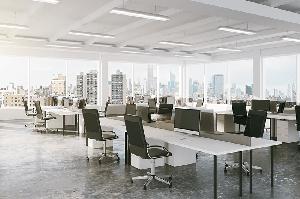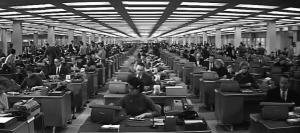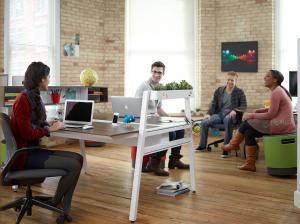Are You Happy Working in an Open Workspace?
Are you happy working in an open office? Read our analysis and let us know about your experience in an open office floor plan.
From the Bullpen to the Action Office to today’s Open Workspace — are work environments evolving faster than we can adapt?
What’s the real cause for all these changes in office design?
If we had to guess, we’d probably say it boils down to the natural desire for business to want to grow and become more profitable. To achieve this, businesses invest in the most current technologies available to help their employees become more productive.
As we look back in time, we can easily see how each generation’s business technology had an influence on office design:
- In the early 1900s, office design had to change to incorporate a succession of new devices, as office communications moved from the telegraph to the ticker tape and the telephone.
- The post World War II era saw another shift. While many office workers were employed typing out documents in secretarial ‘bullpens’, the mainframe computer was making inroads into business offices.
- By the 1960s, collecting, managing, interpreting and distributing information was emerging as a full-fledged business unto itself — becoming as important as manufacturing goods in a factory.
In response to these changes, designer Robert Probst of Herman Miller created an influential line of furniture that lives with us to this day, the Action Office, a concept that many now derisively refer to as office cubicles, cubes or cube farms.
(To learn more about the history of cubicles and ‘cube farms’, we recommend the book Cubed: A Secret History of the Workplace by Nikal Saval.)
While we make fun of cubes today, the original concept was a huge step forward – offering far more privacy and quiet compared to working in the bullpen-style office that preceded it.
Cubicles, as it turns out, were the right design at the right time. As computer technology during the late 1970s and early 1980s got smaller and smaller, cubical designs were ideally suited to be the ‘home’ for the next generation of business technology, the ubiquitous PC desktop computer and monitor combination found on almost every office worker’s desk.
Work Anywhere Technology Leads to Open Workplaces
But technology marches on. Wireless technology and even more powerful devices mean today’s office workers can ‘work from anywhere’ — from the coffee shop to the airport and mid-flight on the plane.
In this new, more mobile world, some high-tech companies began to ask the question… “if an increasing number of our employees are working on the go and outside the office, why should we pay for dedicated cubicles and desktop PCs if they rarely use them?”
And so in the 1990s, high-tech companies, like design software giant Autodesk, began issuing employees notebook computers instead of desktop machines. Employees who traveled extensively or worked remotely would no longer get a dedicated cubicle. Instead, they would be provided temporary ‘hotel’ space at the office – allowing them to plug-in and do their work when they did come into the office. To provide space for collaboration, an ample number of conference rooms were made available to conduct impromptu meetings.
Startup culture took to this approach and made it universal. No more dedicated offices, just open workspaces that looked like a coffee shop — paired with airy, glass-walled conference rooms for meetings.
Has this approach been successful? From all outward appearances, the answer is yes. High-growth companies like Facebook, Google, Twitter, Pinterest all use the open workspace plan, and there is no denying their success.
Around the world, other companies, in other industries, have been trying to unlock the secrets of these phenomenally successful high-tech companies. Is the open workspace part of the ‘secret sauce’ of their success? Does it lead to, as many proponents advocate, an environment where spontaneous collaboration and innovation occurs by design?
More and more employers worldwide are going to find out.
According to the results of the British Council for Offices survey What Workers Want 2016 by Steven Lang of Savills PLC, the number of British workers in traditional office environments has dropped to 77%, while open offices have doubled to 18% in just the last three years. (Rounding out the survey, 3% worked remotely, and 2% worked in business incubators.)
What Advantages do Open Workspaces Offer Employers?
Let’s take a look at the pros and cons of working in an open workspace, both from the employer and employee point of view.
First up, the employer’s view. Here are some of the key benefits employers seek to achieve by implementing an open workspace plan:
Spontaneous Collaboration
It’s true. Many of the great discoveries and innovations can trace their roots back to serendipitous meetings between individuals. With that in mind, most open workspaces are built around elements designed to encourage impromptu encounters. Examples include convenient casual seating areas and informal work tables that allow you to meet face-to-face with your fellow project team members — all in hopes of fostering fateful spontaneous ideas that spur innovation.
Deliver Projects Faster
Whether you use business school nomenclature like first mover advantage, or colloquial expressions like go big or go home, there’s no question that being first in the market with a product or service is more important than ever before. An implicit goal of open workspace design is to help employees to deliver projects faster; in fact, some business leaders consider the open workspace to be a physical manifestation of the rapid software development methodology known as Agile.
Attracting Millennial Talent
An increasing challenge for employers is attracting the best and brightest talent. As it turns out, office design plays an increasingly important role in determining where the Millennial generation wants to work — they are attracted to a contemporary warehouse-style and industrial-looking offices — and open workspace design concepts appeal to them.
Increase Space Flexibility, Reduce Real Estate Costs
The open workspace design concept can reduce square footage requirements by as much as 50% compared to traditional cubicle layouts. This can provide employers a significant saving in real estate leasing costs. Another benefit is flexibility: there is less need to reconfigure dedicated office space each time an employee comes on board or departs the organization.
Flatten Management Structure, Knock Down Silos
Employers also see open workspace offices as an opportunity to flatten their management structure — managers working face-to-face with their direct reports can be less intimidating and distant, which in turn can increase the level of trust and openness.
Knocking down silos in an area within a company that tend to be isolated from other departments is another goal many employers have in mind when moving to an open workspace environment. When members of different departments work together face-to-face, there should be less of a ‘toss it over the wall’ mentality that can occur when company departments are physically separated from one each other.
What Advantages Do Employees See in Open Workspace Designs?
Read more ... https://formaspace.com/articles/office-furniture/happy-working-open-workspace/?utm_source=einpresswire&utm_medium=content&utm_campaign=010417
Kelsea Marshall
Formaspace
8002511505
email us here
Legal Disclaimer:
EIN Presswire provides this news content "as is" without warranty of any kind. We do not accept any responsibility or liability for the accuracy, content, images, videos, licenses, completeness, legality, or reliability of the information contained in this article. If you have any complaints or copyright issues related to this article, kindly contact the author above.





